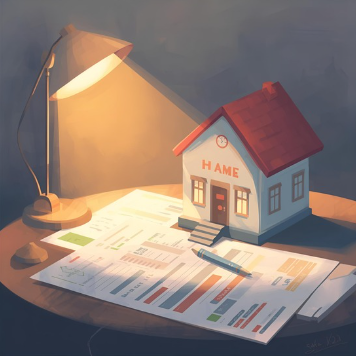Understanding Home Loans
A home loan, often called a mortgage, is a financial agreement that allows individuals to purchase a home without paying the full price upfront. Instead, the borrower repays the loan over time with interest. The amount you borrow is determined by factors such as your income, credit score, and the value of the property. The interest rate, which is the cost of borrowing, can significantly impact your monthly payments and the total cost of the loan over time.
There are different types of home loans to consider, each with its own features. Fixed-rate mortgages maintain the same interest rate throughout the repayment term, providing predictable monthly payments. In contrast, adjustable-rate mortgages start with a lower interest rate that can increase or decrease periodically based on market conditions. Other options may include government-backed loans, like FHA or VA loans, which often come with lower down payment requirements or specific eligibility criteria.

Home loans usually require an initial payment, known as a down payment, which is a percentage of the home’s purchase price. The required down payment amount can vary depending on the loan type and lender. Additionally, lenders may require private mortgage insurance (PMI) if your down payment is less than 20% of the home’s value. This protects the lender in case of loan default.
Repayment terms typically range from 15 to 30 years, with shorter terms generally resulting in higher monthly payments but lower overall interest costs. Longer terms, on the other hand, may make monthly payments more manageable but lead to higher interest expenses over time. Understanding how these factors interact can help you choose a loan that suits your financial needs.
When considering a home loan, it’s important to be aware of associated costs beyond the loan itself. These can include closing costs, property taxes, and homeowner’s insurance. Reviewing the loan estimate provided by your lender can help you understand these expenses and plan accordingly.
Preparing Your Finances
Organizing your finances is a crucial step in the home loan process. Begin by evaluating your current financial situation, including your income, expenses, and savings. This will give you a clear understanding of how much you can afford to borrow and repay comfortably. Setting a budget for your future mortgage payments can help ensure you’re not overextending yourself financially.
Paying down existing debt is another important aspect of financial preparation. Reducing your debt-to-income ratio can improve your chances of qualifying for a loan and receiving favorable terms. Focus on paying off credit card balances and other high-interest debts to strengthen your financial profile. At the same time, avoid taking on new debt, such as personal loans or additional credit cards, before applying for a home loan.

Savings also play a significant role when preparing for a home loan. You’ll need funds for the down payment, which is typically a percentage of the home’s price. Additionally, setting aside money for closing costs and an emergency fund can provide financial security during the buying process. Lenders often prefer to see that borrowers have enough reserves to cover unexpected expenses.
Tracking your spending and reducing unnecessary expenses can further boost your savings. Look for areas in your budget where you can cut back, such as dining out or entertainment, and redirect those funds toward your home purchase goals. Every bit of extra savings can make a difference when it’s time to cover upfront costs and future payments.
Finally, consider consulting with a financial advisor or housing counselor. These professionals can help you evaluate your financial readiness and create a plan tailored to your specific goals. They can also provide insight into loan programs and down payment assistance options that may be available in your area, giving you more choices when it comes to financing your home purchase. By taking these steps to prepare your finances, you’ll be better equipped to navigate the home loan process and make informed decisions about your future.
Choosing the Right Lender
When selecting a lender, take the time to research and compare your options. Lenders can include traditional banks, credit unions, or online mortgage providers, each offering unique benefits and loan products. Look beyond the interest rate to evaluate additional factors, such as loan terms, fees, customer service, and available programs. Some lenders may specialize in specific loan types, like government-backed loans, while others might offer first-time homebuyer incentives or discounts.
Requesting loan estimates from multiple lenders is a practical way to compare costs. These estimates outline key details such as interest rates, closing costs, and monthly payment projections, helping you identify which lender offers the most favorable terms for your financial situation. Pay close attention to any fees listed, including origination fees, application fees, and any potential penalties.
Speaking with a mortgage broker can also be helpful. Brokers act as intermediaries between you and lenders, leveraging their expertise to identify competitive loan options that meet your needs. They may have access to a wider range of loan products than you might find on your own. However, it’s important to understand that some brokers charge fees for their services, so ask about potential costs upfront.

Customer service is another critical factor to consider when evaluating lenders. A responsive and knowledgeable lender can make the process smoother, especially if you encounter questions or challenges along the way. Reading online reviews or seeking recommendations from friends and family can provide insight into a lender’s reputation and the experiences of other borrowers.
Additionally, some lenders offer pre-qualification tools or online calculators that can help you explore potential loan scenarios before you commit to a formal application. These tools can provide a clearer picture of what to expect based on your financial information, giving you more confidence as you move forward.
When reviewing lenders, also consider the flexibility of their loan options. Some may offer tailored solutions, such as the ability to lock in an interest rate during the application process, which can be beneficial if rates are expected to rise. Taking the time to understand your options and what each lender can provide will ensure that you choose a lending partner who aligns with your specific home-buying needs.
Starting the Application Process
The application process begins by working closely with your chosen lender to provide the necessary details about your financial situation. You’ll typically need to complete an application that requires information about your income, assets, debts, and employment history. This information helps the lender assess your ability to repay the loan and determine the amount you may qualify to borrow.
During this stage, lenders will often conduct a credit check to evaluate your creditworthiness. Your credit score plays a significant role in determining your loan terms, including the interest rate and overall approval. Be prepared to discuss your financial goals and any questions you have about the loan options available to you.
After reviewing your application, the lender may provide a pre-approval decision. Pre-approval involves a more detailed evaluation of your financial profile, giving you a better understanding of how much financing you could secure. This process may require additional documentation, such as bank statements or tax returns, to verify your financial information. Receiving a pre-approval letter demonstrates to sellers that you’re a serious buyer, which can strengthen your position when making an offer on a property.
If you haven’t already selected a specific property, your lender can outline how the loan process will proceed once you find a home. At this stage, it’s important to ask questions and ensure you understand the next steps in the timeline, including deadlines for submitting documents or making decisions.

Many lenders provide online tools or platforms to track the progress of your application, upload documents, or communicate with their team. Taking advantage of these tools can help you stay organized and streamline the process. Make sure to respond promptly to any requests for additional information, as delays can impact your application’s timeline.
Submitting Required Documentation
When moving forward with your loan application, providing the requested documentation in a timely and accurate manner is crucial to avoid potential setbacks. Lenders typically require proof of income to confirm your ability to make consistent payments. Common examples include pay stubs, W-2 forms, tax returns, or, if you’re self-employed, profit and loss statements. These documents help verify your financial stability and reliability as a borrower.
In addition to income verification, you’ll likely need to supply recent bank statements, which give insight into your savings, checking accounts, and overall financial habits. Lenders use this information to assess whether you have sufficient funds for the down payment, closing costs, and any reserves they might require. It’s important to provide all pages of the bank statements, even if some appear blank, as lenders often require the complete document for review.
If applicable, you may also need to provide details about any other assets you own, such as retirement accounts, investments, or property. Documentation that demonstrates the value of these assets can further strengthen your application by showing you have additional resources available.
For verification purposes, lenders will also request government-issued identification, such as a driver’s license or passport, to confirm your identity. If you are purchasing the property with a co-borrower, they will need to submit their identification and financial documents as well.
Once you’ve selected a property, you will need to provide the purchase agreement, which outlines the terms of the home sale. The lender uses this document to confirm details about the property and to move forward with ordering an appraisal, which is required to determine its market value.
Throughout the documentation process, be prepared for the lender to request additional materials or clarifications, especially if there are discrepancies or missing details in your initial submission. Responding quickly and thoroughly to these requests is essential to keep your loan on track. Utilizing online tools or platforms provided by your lender can make it easier to upload documents securely and monitor the status of your application.
Closing the Loan
The closing process marks the culmination of your home loan journey. This stage involves a detailed review of the final loan documents to ensure all terms align with what was previously discussed. You’ll have the opportunity to examine key details, such as the interest rate, loan amount, repayment schedule, and any closing costs or fees included in the agreement. Carefully verifying the accuracy of these documents is critical, as even minor discrepancies can cause complications later.
During the closing appointment, you’ll also complete the necessary paperwork to finalize the loan. These documents may include the promissory note, which outlines your commitment to repay the loan, and the mortgage or deed of trust, which secures the lender’s interest in the property. Take your time as you review each form, and don’t hesitate to ask for clarification on any terms or figures you don’t understand. If applicable, this is also when you’ll pay any remaining closing costs or down payment funds.

Once all documents are signed, the lender will initiate the funding process. This means the loan amount will be transferred to the seller or escrow account, officially completing the purchase. In some cases, you may receive the keys to your new home immediately, while other transactions might require a short waiting period for the funds to clear.
It’s a good idea to keep copies of all signed documents for your personal records, as these may be helpful for future reference. Additionally, you should receive a closing disclosure summarizing the final terms and costs of your loan. This document is especially important for ensuring transparency and confirming that everything matches your expectations.
As the final step, confirm any next steps with your lender or escrow agent, such as setting up your first mortgage payment or arranging for property tax and homeowner’s insurance payments. Staying organized and proactive during this stage will help ensure a smooth transition into homeownership.
